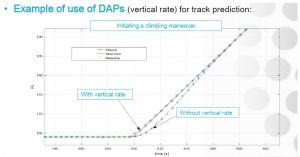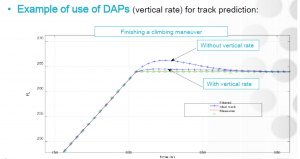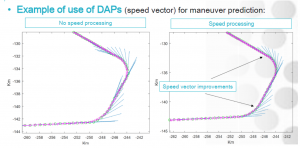58TH ANNUAL CONFERENCE, Conchal, Costa Rica, 20-24 May 2019Agenda Item: B.5.8 – WP No. 92Operational use of DAPs
|
Summary
Many parameters are available from Mode S, ADS-B UAT (Universal Access Transceiver) and ADS-B ES (Extended Squitter) i.e. (Mach number, indicated airspeed, vertical speed, heading etc.) There are no provisions about how or if there is a need to check them for validity. Mode C for example is supposed to be checked when the aircraft is identified for the first time but there is nothing in the ICAO document about other data.
Introduction
1.1 DAPs (Down-link Aircraft Parameters) are small packages of information downloaded from the aircraft, providing additional information regarding intention and movement. Depending on system capabilities and aircraft equipage, ATM systems may get the following information and display it on a controller working position:
- Selected altitude
- Ground speed
- IAS/Mach #
- Roll, track angle
- Magnetic heading
- Vertical rate (barometrical rate of climb/descent)
- ACAS Resolution Advisory notification
1.2 Aircraft DAPs are currently being transmitted and used in many ANSP’s in an operational environment, both at the CWP (Controller working Position) and in the ATM systems to provide enhanced tracking abilities.
1.3 In many cases ATCOs are working with modern ATM-Systems where DAPs data is being shown to them on surveillance displays. There is a critical need for clear, unambiguous and harmonized rules, procedures and training to be developed on how to use down-linked airborne data and DAPs by ATCOs and how the ATM-system displays them.
1.4 Use of DAPs can improve ATM system efficiency, performance and safety when detecting changes in direction (vertical and lateral) and speed.
Discussion
2.1 Operational use of Mode-S down-linked aircraft parameters
2.1.1 Mode S has the capability of transmitting aircraft’s onboard parameters, knowns as DAPs (Down-link Aircraft Parameters) Ground based ATM (Air Traffic Management) systems can use this set of data to both enhance target processing and tracking ability, and provide ATCO’s with warnings when settings on board the aircraft differ from an ATC clearance. Depending on the ATM systems’ capabilities and adaptations, other DAPs sent can be displayed at the Controller Working Position.
2.1.2 Depending on system capabilities and aircraft equipage, ATM systems may get the following information and display it on a controller working position:
- Selected altitude
- Ground speed
- IAS/Mach #
- Roll, track angle
- Magnetic heading
- Vertical rate (barometrical rate of climb/descent)
2.1.3 Avionics data sets transmitted by the aircraft are stored and sent down in 56 bit-wide Binary Data Store (BDS) registers. Common BDS registers used for ATS purposes are:
- BDS 2,0 ARCID (aircraft ID)
- BDS 3,0 ACAS active Resolution Advisory
- BDS 4,0 Selected vertical intention
- BDS 5,0 Track and Turn report: Roll Angle, True Track angle, Ground speed, True Airspeed
- BDS 6,0 Heading and Speed: A/C heading, Indicated Airspeed, Mach number, vertical rate (barometric)
2.1.4 Local policies for training and procedures shall be put in place prior to implementation. Controllers shall be adequately trained prior to operational use. This is supported by existing policy. IFATCA policy is:
|
Operational controllers shall be involved in the design, development and implementation of new ATM systems. Their role shall include:
|
(IFATCA. (2018). TPM, 2018 Ed., AAS 1.3)
2.1.5 Any information downlinked and subsequently displayed at an operational working position should be certified to be used operationally. Any information downlinked that is not certified to base control decisions on should not be displayed.
2.1.6 With BDS 4,0 there are some limitations that need to be understood by the controller. ATM Procedures Development Sub-Group (APDSG) of Eurocontrol and ICAO insist in saying that it is necessary that the limitations of selected altitude/level must be properly understood by the air traffic controllers, as:
a) data presented indicates intention, only. Hence, it cannot be used for separation;
b) there may be situations where, despite the flight crew complying with ATC clearances and instructions, the displayed selected level varies from the cleared level:
i) along SID/STARs with vertical restrictions pilots may select the final cleared level and utilize the aircraft flight management system to achieve the vertical constraints.
ii) on final approach, where at given moments pilots may pre-select the missed approach point (MAP) altitude. The ATC system should normally inhibit the display of the selected altitude in the track label before this occurs to avoid any confusion. If the system detects that the aircraft has broken off the approach and is climbing then the selected altitude will automatically be displayed again providing the controller with the aircraft’s revised intention.
iii) when the aircraft is being flown manually, in particular in response
to vertical avoiding action maneuvers.
iv) Where there is an incorrect barometric pressure setting in the FCU.
2.1.7 The use of BDS 4,0 or PSA (Pilot selected altitude) should be easiest to implement.
- PSA should be considered as a controller tool.
- An alert should be presented to the controller for aircraft with a mismatch between PSA and the Cleared Flight Level (CFL).
- Display of the PSA cannot and shall not be used by ATC to provide separation
- The display of a PSA shall not be used as a substitute for a readback.
- A timeout period should be applied to allow for the new levels to be selected and validated in the cockpit. This is necessary to prevent unwanted alerts.
2.1.8 Consideration should be taken into procedure design of alerts generated for PSA alerts with intermediate altitudes, i.e. a level selected that does not match the CFL but is in-between the current FL and the CFL. These alerts should either be filtered, or a controller should only be required to confirm the cleared level once. Example: Aircraft at FL200 is given a decent to FL100 on a STAR, and due to either company SOP, aircraft capability or pilot training on the aircraft system, an intermediate altitude (ie. FL126) may be selected to comply with waypoint restrictions or for other reasons.
2.1.9 When presenting DAP’s to the controller there should be consultation with the controllers as to what data should be displayed at an operation position. As the ability to add more DAP’s are continuously being added by avionics companies, care should be exercised to not overload the controller with insignificant data. There could be a separate panel, tab or extended tag to access the information, this is to avoid increasing the size of the aircraft label unnecessarily. For example, Indicated Airspeed, Mach number and Magnetic heading downlinked information could be viewed by the controller via a deliberate selection of an extended aircraft label or a separate panel.
2.1.10 ATM systems should provide the ability to suppress DAP’s received from A/C that are deemed to be faulty or inaccurate. This information should be shared with the pilots of the affected A/C, Airline and other ATC units in an attempt to document and correct faulty aircraft. IFATCA has existing policy that covers this:
| Any broadcast on incorrect ATM data should be corrected or if unable then: Switched off, or Marked as invalid. |
(IFATCA. (2018). TPM, 2018 Ed., AAS 1.3)
2.1.11 With the processing of BDS 3,0 (ACAS resolution advisory) depending on ATM system capability, there is the capability to alert controllers that an Aircraft has received an ACAS RA advisory. On receipt of ACAS Resolution Advisory notification, a prominent notification could be displayed. The indication would be removed when the ACAS RA is resolved. However, due to the fact that there could be timing and integrity issues with the receipt the BDS 3,0 from the A/C, IFATCA policy is:
| IFATCA is opposed to down linking of any advisories generated by ACAS. |
(IFATCA. (2018). TPM, 2018 Ed., AAS 1.1)
2.1.12 Unlike validating Mode C upon initial check-in, there should be no need to initially cross check the data being provided by DAP’s unless there is an obvious discrepancy. DAP’s are directly downloaded from the aircraft and with an exception to PSA, DAP’s are not subject to pilot input, therefore eliminating human error. Any significant discrepancy between the displayed information and what the pilot reports should be documented and investigated.
2.2 Integrating Mode S DAP’s into ATM systems to improve system efficiency and performance
- Using BDS 5,0 and 6,0 in conjunction with surveillance data can improve system efficiency in predicting changes in heading, speed variations and vertical profile.
- Utilizing information from DAPs paired with conventional surveillance data will aid the ATM system in seeing changes sooner than with surveillance input only.



2.3 BDS code interrogation strategy
2.3.1 Normally, the more BDS’s requested by the Mode S interrogator, the more information can be extracted from the aircraft transponder registers. It will also help the controller get the aircraft’s flight status and flight intention more rapidly. However, available bandwidth has to be considered. By selectively choosing how often to receive data from particular BDS registers, the controller will still get information on a timely basis, but keep from overloading the ATM systems and data gateways.
2.3.2 ATM systems could be built and/or adapted to modulate how often a certain BDS register is downlinked. For example, if a controller inputs a CFL, the ATCO wants to get more information about the aircraft’s current vertical intentions. It is suggested that Mode S surveillance can give priority to BDS code 4,0 over BDS code 5,0 and BDS code 6,0, and set the request cycle equal to the antenna scan cycle (e.g. the update period of BDS code 4,0 is 4 seconds, the update period of BDS code 5,0 and BDS code 6,0 is 8 seconds or even longer).
2.4 Data transmission requirement
2.4.1 With regards to the implementation of Mode-S, ANSP’s need to take into consideration the extra stress put on the data transmission infrastructure of the ATM system. With older legacy systems, or in remote areas where the surveillance site does not have adequate data transmission bandwidth available, there could be a risk of loss of data or surveillance returns reaching the ATM systems at a rate below acceptable minimums.
2.4.2 All Purpose Structured Eurocontrol Surveillance Information Exchange (ASTERIX) format is widely used for the surveillance data transmission. Normally, the data transmission uses the High- level Data Link Control (HDLC) protocol and the transmission rate is set to 9.6kbps or 19.2kbps. If the amount of aircraft is large in the Mode S surveillance coverage, such as 120 aircraft and more, the transmission rate 19.2 kbps may not meet the real-time requirement and may lead to the output buffer overflow.
2.4.3 According to the data statistics and analysis, if the synchronous High-level Data Link Control (HDLC) protocol is used to transmit the surveillance data, the average length of the Mode A/C surveillance data packet is 25 bytes, while the average length of Mode S surveillance data packet is 85 bytes. If there are more than 120 aircraft within the coverage and the tracks are updated every 4 seconds, the amount of surveillance data transmitted by the transmission equipment should be more than 20.40K bits (85 x8 x 120/4/1000) per second, and the complete real-time transmission of surveillance signals can be achieved. It is recommended to implement 38.4kbps or higher transmission rate to avoid abnormal phenomenon such as surveillance data delay or output buffer overflow caused by low transmission rate.
2.5 Initial Implementation Principles and Phases
2.5.1 As suggested by ICAO:
|
5.1 Implementation Principles Implementation guidance is to be developed that consider with Mode S and classical transponder equipped aircrafts. The Mode 3/A Code should continue to be used. The Mode S transponder should answer both Mode A/C interrogation and Mode S interrogation. The Mode S interrogator is capable of performing the conventional surveillance function with Mode A/C transponders. The implementation plan is to be developed that consider with the requirements on the surface and in the air. With the difference situation of every member/state, it will only give the advice for Mode S DAPs implementation plan, the member/state can develop its own implementation plan. 5.2 Implementation Phases 1) Conduct operational test and evaluation: 2) Obtain systems certification: 3) Obtain regulatory approvals: 4) Implementation transition: 5) Performance monitoring to ensure that the agreed performance is maintained. |
(The first working group meeting of mode S downlinked aircraft parameters (MODE S DAPs WG/1) WP03_CHN and HKG Mode S DAP’s Implementation and Operation Guidance Document v3)
3. Conclusions
3.1 Mode S DAP’s integration into an ATM system can improve safety, giving controllers alerts when mismatched data is detected.
3.2 Unlike validating Mode C upon initial check-in, there should be no need to initially cross check the data being provided by DAP’s unless there is an obvious discrepancy. DAP’s are directly downloaded from the aircraft and with an exception to PSA, DAP’s are not subject to pilot input, therefore eliminating human error. Any significant discrepancy between the displayed information and what the pilot reports should be documented and investigated.
3.3 Consideration needs to be taken when displaying DAP’s at a CWP as to not unnecessarily increase the size of an aircraft label.
3.4 DAP’s data can be beneficial to an ATM system making it more accurate and provide quicker performance in displaying a change in profile both vertically and laterally.
3.5 Consideration needs to be taken on existing infrastructure when implementing Mode S DAP’s as it could lead to a data buffer overflow, but mitigations can be put in place to reduce the amount of unnecessary data transmitted during level flight.
Recommendations
4.1 It is recommended that IFATCA policy is:
When using downlinked Altitude (PSA):
- It shall not be used to provide separation
- The display of a PSA should not be used as a substitute for a readback
- An alert should be presented to the controller for aircraft with a mismatch between PSA and the Cleared Flight Level (CFL)
- Nuisance alerts should be kept to a minimum
- An alert timeout period should be applied to allow for a new level to be selected in the cockpit
And is inserted in the IFATCA Technical and Professional Manual.
4.2 It is recommended that IFATCA policy is:
Any information displayed at a controller working position shall be approved to be used operationally.
And is appended to the existing policy WC 8.2.8 in the IFATCA Technical and Professional Manual.
4.3 It is recommended that a review of policy AAS 1.2 be conducted by the TOC and be added to next years’ work programme.
References
- ICAO Doc 4444 ICAO. (2018) PANS-ATM (Doc 4444). 16th Edition. ICAO: Montréal, Canada
- IFATCA Technical and Professional Manual, 2018 edition
- https://www.icao.int/APAC/Meetings/Pages/2018-DAPs-WG1.aspx
- WP from Seminar on Mode S Downlinked Aircraft Parameters and the First Working Group Meeting of Mode S Downlinked Aircraft Parameters
- Eurocontrol Mode S programme
- WP from previous IFATCA conferences


